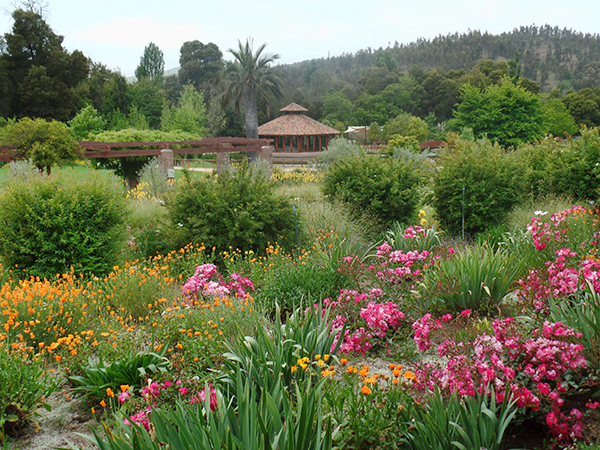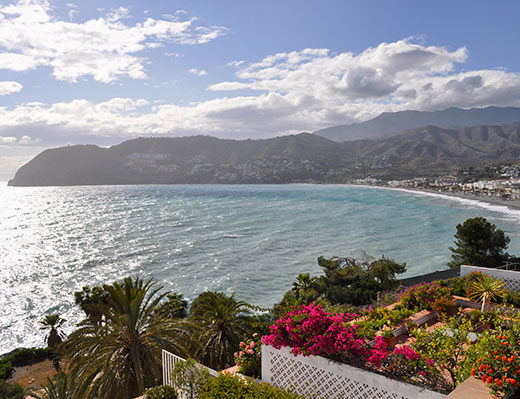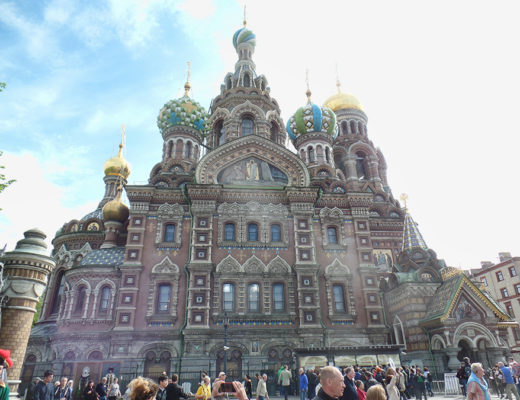Maybe the third time is supposed to be the best. I always thought the first time was, but when it comes to visits to Chile, our third time revealed a depth and breadth that we had not perceived on our earlier visits. Maybe it is because by now, Mauricio, our guide is like an old friend. He understands us, we talk about all kinds of things, and our interests in wine are adventuresome. This Mauricio likes because he can show us wines and wineries and production methods that are on the cutting edge in some instances. On this trip we had instructed Mauricio that we wanted to go to wineries that produced interesting Petite Verdot and Carignan wines.
Santiago from Hotel Window
Mauricio Rodriguez Masserano is President of Chilean Wine Lovers (maurice@cwl.cl – 001 714 845 7150 – yes, that is a US number.) He is our guide and friend and mentor when it comes to all things Chilean and Chilean wine.
On this trip we stayed longer than usual, because the flight costs were substantially lower by staying on. After our overnight flight from DFW, we arrived in Santiago mid-morning. Later than on our earlier flights. We asked Mauricio to take us to a winery by the name of Odfjell. I had been able to find their Carmenere at a wine store near my home and thought it one of the best I’d had at that point. But the wine store closed and I hadn’t been able to find it in Dallas since. When we arrived we learned that Dan Odfjell is a Norwegian ship owner who built a winery in Chile in the Maipo valley. Over time he added vineyards in Lontue Valley and Maule Valley, which affords him a variety of climates, soils and weather conditions. He also diversified his grape types and is using both organic and biodynamic processes. I was only familiar with their Carmenere and Cabernet Sauvignon. When we visited we learned about the processes and that they were producing limited quantities of a variety of grape types. They also have interesting blends from the new types they are producing. One attraction of this winery is the Norwegian horses they have brought in and actually use in their production. We didn’t bring anything to feed the horses so they weren’t very interested in us, but the tasting made it more than worth the trip.
That afternoon we visited Undurraga winery. This family has been producing wines in Chile since 1882 and now exports to 70 countries on five continents. The winery has interesting gardens that were designed by a French landscaper by the name of Pierre Dubois and a wide range of wines to explore. Almost as an afterthought I picked up a couple of bottles of Bodega Volcanes de Chile, Parinacota limited edition Syrah-Carignan. This is an experimental wine produced by Undurraga from volcanic soils. The guests to whom I served it and I thoroughly enjoyed both bottles. Undurraga wines are not as expensive as some of the wines we brought back, but seem to be excellent value wines.
That night we returned to Matetic and La Casona, a guest house for wine buyers we visited on our second trip. The evening was every bit as special as on the first trip. A great meal with excellent wines and beautiful gardens and vineyards surrounding.
La Casona Restaurant at Matitec Winery
Vik is a Norwegian entrepreneur who wanted to produce not only a world class wine, but also provide world class accommodations at his winery. He has accomplished both. We approached the valley by a circuitous route, but we knew when we were getting close as we saw what appeared to be a flying saucer on the top of a hill off in the distance. As we got closer, the gleaming silver building became more discernable. Soon we could see it was the hotel that serves as the focus on those who come to visit. There are 11,000 acres to the estate. Francesca, our Vik guide, took us out for a tour in a heavy duty SUV. We thought this was necessary given the rugged terrain, but we would come to realize this wasn’t the only rugged terrain we would visit this trip. After a tour of the vineyards behind the hotel, and the hidden lake we only discovered once we were out in the vineyards, we returned to the state of the art winery building. It is mostly underground with water running across the surface or roof, we would discover. The water helps maintain the proper temperatures below. The wine tasting reminded me of Domus Aurea. We were told by Francesca that the Vik wine is produced from three variety of grapes and that each grape is produced individually and blended at the end. This is not unusual other than each could be a stand alone wine. To prove that she gave us a barrel tasting of each of the three grape varieties and ended with a tasting of the Vik wine itself. The wine is expensive and can be shipped directly from the winery, which is the choice we made. After the tasting Francesca took us to the hotel where we had lunch. It was an incredible lunch. Gourmet by any standard. It also came with a full bottle of Vik wine for lunch. Obviously we enjoyed it very much, particularly when they seated us outdoors overlooking the lake, the vineyards and the hills surrounding. Peaceful, and just an incredible experience. But that wasn’t even the best part of the visit. We asked if we could see one of the rooms. There are twenty-four on site. Each room is individually decorated and features significant investments in original artwork. The variety of room décor made it difficult to decide which room I would have wanted to stay in. As we left Vik, having experienced something unique in all the world, we looked forward to the case of wine that would greet us shortly after our return.
After our day at Vik, we checked into Terravina in Colchagua Valley. The room was not nearly as spectacular as at Vik, but the price tag was a lot friendlier. The owners were very cordial and helpful. Nearby is a restaurant, Etiqueta Negra, where the owner and chef greeted us. Mauricio brought out several different wines for us to taste before dinner and the chef brought out appetizers that he and Mauricio had agreed upon to go with the wines. Dinner was the chef’s take on variations of traditional Chilean dishes. All were excellent and it provide a great way to start looking forward rather than just dwelling on the Vik experience. The next day we went to Laura Hartwig, a small estate winery with a long history, but virtually unknown outside Chile. One of their special wines is a Petite Verdot and the reason for our visit. The young winemaker was very knowledgeable about winemaking processes and the innovation going on in the industry. We also learned he has been in some of the classes on winemaking that Mauricio has been attending. They got into some technical discussions while we listened, developing a whole new appreciation for the variety of wine styles that are possible. We also took a horse pulled wagon ride through the vineyards.
Viu Manent – vineyard tours
We drove on to Casa Silva the next day, skipping another winery that was on our original agenda but now out of the way since we had not driven to Talca the night before. Casa Silva is a winery I had high on my list of places to visit. A pilot friend who often flew into Chile had brought back bottles that he served at dinner parties. I greatly enjoyed their wines and hoped to learn more about them. When we arrived, Mauricio drove us through a vast vineyard of 90 year old vines, and then took a right. Soon we emerged into an area where there was a polo field, polo stables and restaurant that overlooked the polo field. Lunch was at the restaurant, although there was not a match going on that day. It was very pleasant to overlook the field while we had our three course lunch with a bottle of a Casa Silva Carmenere. While we were at lunch I noticed my spouse take all the sugar cubes from the bowl on our table. When we finished she headed directly to the stables where she introduced herself to each of the dozen or so polo ponies, feeding each a cube of sugar. It goes without saying that the polo ponies were talking to her as she went down the row, like they were saying, ‘come back here. I want more of that.’ She complied feeding hay to each on the return trip through the stables since she ran out of sugar. The tastings were exceptional and the Casa Silva Microterrior de Los Lingues Carmenere is among my favorites from this trip. Casa Silva also claimed two gold medals in Brussels at their 2006 global wine show. Since we were in the area, we convinced Mauricio to stop by Viu Manent, which was the first winery he took us to seven years before. We bought eight bottles of a sampling there of wines we can’t find in the US and then convinced Mauricio to stop by Montes, also close by where we found the new wines they were trying out that are not currently available in the US. Montes had been badly damaged in the 2010 earthquake and the winery was significantly different than the previous visit we had made. But my spouse got to commune with the angel in the lobby again and that made her happy.
On the fifth day we visited Vina Perez Cruz and El Principal wineries with a visit to an individual producer who agreed to make empanadas for us for lunch. Vina Perez Cruz produces a Carmenere that I very much like. What I discovered when we visited is that they also produce some excellent blends. So of course we walked out of there with a case of a variety of kinds I’d never seen.
That afternoon we arrived at Vina El Principal in Pirque, Maipo Valley. Another winery I’d never heard of. This winery is in the high end of the Maipo Valley. We glanced about and could see vines going up the sides of the mountains around us. Our El Principal guide showed up in a four-wheel drive vehicle made by Mahindra in India and hardly looking up to the task. But she drove us up to the top of the upper most rows of vines. From there we could see for miles. All vineyards and a few villages. From the top I wasn’t quite sure how we were going to get down without the car going head over heels, but somehow we did and the Mahindra got us back safely. During the wine tasting we discovered that we very much like their Cabernet and Carmenere blends. The tasting was down in the wine cellar. The host provided us with a tasting wheel that gave us information about the various tastes we were picking out in the bouquet and flavor of the wine. We were glad we came to El Principal, not only for the unique view from the top of the mountain, but because they are producing superior wines with a different bouquet and taste that are very enjoyable.
We spent our last night at the Bonaparte Boutique Hotel at Mar del Plata, 2171 in Providencia, Santiago. This was in a well-developed area of the city. We walked around the city and found a restaurant Mauricio had recommended. An excellent meal in a typical neighborhood restaurant. The hotel itself was very modern and well situated. It was an enjoyable last night in Santiago.
Mauricio had kept the best for last.
We returned to the wine store in Santiago that had been the site of my ‘pretty woman’ experience four years earlier. They were no longer doing the unlimited wine tasting as other wine stores had complained that they didn’t have a permit to do tastings. So consequently they couldn’t get the permit until they had one sufficient penitence. We did find some interesting buys, most of which they crated for us in wood crates we were able to bring back on the airplane (in check baggage).
We had sampled an old vine 100% Carignan wine from Re winery before our trip. We very much wanted to visit this winery and Mauricio came through. We learned that it was owned by the owner of Morande. His son is the winemaker and the name Re, is short for renew. They are attempting to use more traditional methods to produce wines. They are also trying to produce premium wines from grapes that are not traditionally found in Chile such as the Carignan. We learned that they have branded the wine as Vigno and are trying to produce it in the egg-shaped vats that we had first seen at Antiyal four years earlier. Their Carignan has an incredible bouquet and body unlike anything I’ve had the privilege to try before. While Vigno was not imported into the US at the time of this writing, they were working on signing with an importer and hoped to be in the market by 2018.
We arrived at the airport with 104 bottles of wine, bubble wrapped and some in wooden cases. Mauricio helped us bring it in and plastic wrap it just as we had on our previous trips. He helped us get it checked in and then we said our good-byes at the airport. As I said earlier, Mauricio has become a guide, a mentor and a friend. He has taught us a great deal about wine, about life in Chile and South American culture, and he has reinforced our belief that there are great people anywhere you go in the world. You just have to look for them and not be afraid to ask questions.
Vineyards in September





No Comments